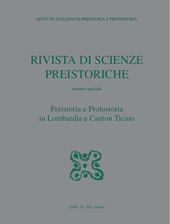La Balma dei Cervi di Crodo e le pitture rupestri dell'Ossola : documentazione, analisi e studio
P. 393-409
The painted rock wall of the Balma dei Cervi (the shelter of the deer), discovered in 2008, is one of the most important in the Alps. The multidisciplinary study project involved iconographic documentation, archaeological digging, geological study, SEM-EDS and μ-Raman pigment analysis. The activities were also extended to the Balma del Capretto (the shelter of the baby-goat), recently discovered, and to the Balm 'dla Vardaiola (the sentinel shelter). During the archaeological digging at the Balma dei Cervi, splinters and lithic tools in flint and rock crystal and pottery fragments were found; the latter attest to a presence dating back to the Middle Neolithic. The pigments contain hematite, suggesting the use of red ochre, and the patinas are composed of calcite and gypsum.
The iconographic documentation has produced a detailed tracing, the complete catalog of figures (100 painted and two engraved), a D-Stretched photo documentation and SFM 3D modeling. The dangerous path and the protection requirements prevent public access. To overcome this problem, the Virtual Museum of the Balma dei Cervi (www.balmadeicervi.it) was created; thanks to spherical panoramas, fake-color high-resolution photo mosaics, tracing, and 3D models it shows the painted wall with greater detail than in the real view. The stylistic comparisons with Iberian, south-France and western Alps schematic art (rock paintings) suggest a Neolithic-Copper Age chronology; nevertheless, a comparison with the Valcamonica-Valtellina praying figures, which are engraved and not painted, cannot exclude a more recent chronology, related to the latest phases of Bronze Age. [Publisher's text]
Forma parte de
Rivista di scienze preistoriche : LXXII, supplemento, 2022-
Artículos del mismo número (disponibles individualmente)
-
Información
Código DOI: 10.32097/1183
ISSN: 2282-457X


